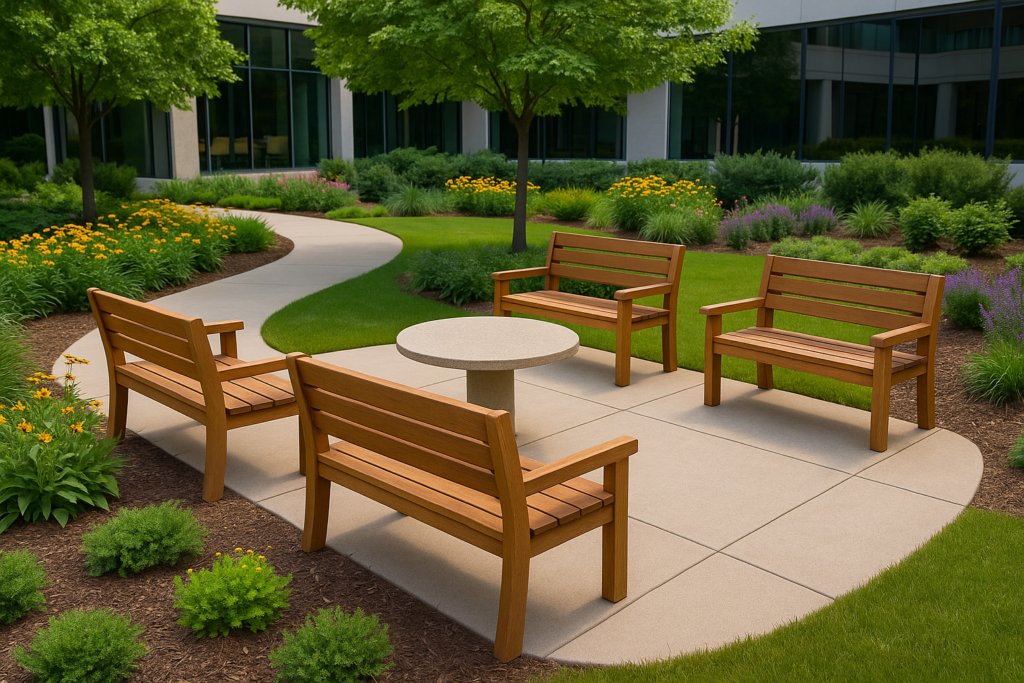In the hustle of today’s corporate environments, spaces that support relaxation and mental rejuvenation are no longer a luxury—they are essential. A beautiful landscape that integrates thoughtfully designed seating areas creates opportunities for employees, clients, and visitors to take meaningful breaks, improving wellness, productivity, and workplace satisfaction.
This guide explores how seating areas can be woven into the fabric of professional outdoor environments with practical and aesthetic intent. This article offers actionable guidance for integrating restful spaces within your landscape design architecture.
The Value of Outdoor Seating in a Beautiful Landscape
Promotes Wellbeing and Mental Clarity
Outdoor seating areas allow individuals to decompress, recharge, and connect with nature. These environments foster mindfulness, reduce stress, and support emotional well-being.
Encourages Informal Collaboration
Benches, nooks, and shaded tables offer informal settings for spontaneous conversations and idea sharing. Employees can brainstorm or socialize in spaces that are less rigid than boardrooms.
Enhances Aesthetic and Spatial Experience
Seating areas punctuate a landscape design by providing visual rhythm and functional depth. A well-placed bench can frame a view, guide movement, or offer a focal point.
Planning Landscape Seating Areas with Intent
Begin with a Landscape Drawing
Every effective seating zone starts with a detailed landscape drawing. This should outline circulation paths, planting zones, lighting elements, and seating options, ensuring integration with both the natural and built environment.
Analyze Microclimates and Exposure
Sunlight, wind direction, and shade coverage all influence how comfortable a seating area will be. Use trees, pergolas, or structures to provide protection from the elements.
Select the Right Zones
Common zones ideal for seating include:
- Courtyards
- Garden alcoves
- Shaded walkways
- Water feature perimeters
- Roof terraces
- Pocket parks within campuses
For large or connected office spaces, see Beautiful Landscape Layouts for Multi-Building Campuses.
Types of Seating Features
Built-In Benches
Incorporate stone or wood benches into retaining walls or raised planters. These permanent fixtures require less maintenance and blend organically with the landscape design architecture.
Freestanding Furniture
Choose weatherproof chairs and tables made from powder-coated metal, composite wood, or recycled materials. Modular furniture allows flexibility and adaptability.
Hammocks and Lounge Chairs
In wellness zones or garden retreats, lounge seating promotes deeper relaxation. Use on soft lawns or under shady trees.
Artistic and Branded Seating
Design seating that doubles as art or reflects your corporate identity. Consider engraved messages, branded shapes, or sculptural forms. Learn more from Beautiful Landscape Art Integration for Corporate Identity.
Sustainable and Low-Maintenance Design Choices
Native Plant Integration
Surround seating areas with native or drought-resistant plants that require minimal upkeep and watering. These choices support beautiful landscape sustainability.
Permeable Surfaces
Use decomposed granite, gravel, or permeable pavers beneath seating areas to reduce runoff and improve drainage.
Solar Lighting and Shade Structures
Install solar-powered fixtures and passive shade systems to reduce energy consumption and increase usability in all conditions.
Encouraging Movement and Relaxation
Connect Seating with Walkways
Place seating along or at the ends of walkways to encourage exploration and pause points. See strategies in Beautiful Landscape Walkways That Inspire Daily Movement.
Add Sensory Elements
Incorporate fragrant flowers, rustling grasses, water sounds, or tactile materials. These multi-sensory cues enrich the environment and support relaxation.
Include Quiet Zones and Open Spaces
Offer a balance of secluded seating for solitude and open clusters for conversation and group gatherings.
Working with a Landscape Contractor
Expert Site Evaluation
Professional landscape contractors analyze wind flow, topography, and soil to optimize seating placement for comfort and stability.
Functional and Aesthetic Balance
Contractors help match seating styles to your site’s overall landscape design, ensuring cohesion in color, material, and proportion.
Long-Term Durability
Professionals select low-maintenance, high-durability solutions suitable for high-traffic or seasonal exposure environments.
Final Thoughts
Integrating seating areas into a beautiful landscape elevates your outdoor environment from a visual asset to a dynamic, functional space. Whether it’s a shaded bench along a garden trail or an open-air patio with sculptural seats, these elements transform break time into a wellness experience.
With a clear landscape drawing, the guidance of experienced landscape contractors, and a commitment to comfort, sustainability, and design integrity, your campus or workplace can become a haven for inspiration and rejuvenation.

